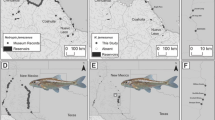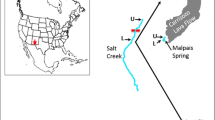Abstract
The Warm Springs pupfish (Cyprinodon nevadensis pectoralis) inhabits several low flow (<0.15 cfs) springs in an otherwise dry Mojave Desert landscape. Increasing demands on groundwater coupled with predictions of decreased precipitation from global warming make this species a sentinel for biodiversity dependent on springs. Here we examine mitochondrial DNA haplotypes and nuclear microsatellite genotypes for individuals sampled in 1998 and 2007 as a means of inferring the historical demography of the subspecies. Estimates of genetic effective population size from comparison of allele frequencies over time underscores that all spring populations support small populations, typically <100 individuals. Such small population sizes suggest spring populations may have heightened probabilities of extirpation. Despite small population sizes, all springs harbor relatively high levels of genetic variation for both nuclear and mitochondrial DNA. Unexpectedly high levels of variation may be explained by recent declines in population size coupled with rare episodes of gene flow between springs suspected of occurring during flooding events. The inferences gained from the genetic data provide the basis for evaluating current and future restoration plans. The genetic data suggest there is a need to balance the predicted positive effects of restoring hydrological connectivity with the potential negative impacts of providing avenues for the spread of exotic species detrimental to pupfish populations.







Similar content being viewed by others
References
Anderson EC (2005) An efficient Monte Carlo method for estimating Ne from temporally spaced samples using a coalescent-based likelihood. Genetics 170:955–967
Burg TM, Wilcox JL, Martin A (2002) Isolation and characterization of polymorphic microsatellite loci in pupfish (genus Cyprinodon). Conserv Genet 3:197–204
Deacon JE (1979) Endangered and threatened fishes of the West. Great Basin Nat Mem 3:41–64
Deacon J, Deacon-Williams C (1991) Ash Meadows and the legacy of the Devils Hole pupfish. In: Minckley W, Deacon J (eds) Battle against extinction, Chap. 5. University of Arizona Press, Tucson, pp 69–87
Deacon JE, Williams AE, Williams CD, Williams JE (2007) Fueling population growth in Las Vegas: how large-scale groundwater withdrawal could burn regional biodiversity. Bioscience 57:688–698
Drummond AJ, Rambaut A (2007) BEAST: Bayesian evolutionary analysis by sampling trees. BMC Evol Biol 8:214
Drummond AJ, Rambaut A, Shapiro B, Pybus O (2005) Bayesian coalescent inference of past population dynamics from molecular sequences. Mol Biol Evol 22:1185–1192
Duvernell DD, Turner BJ (1998) Evolutionary genetics of Death Valley pupfish populations: mitochondrial DNA sequence variation and population structure. Mol Ecol 7:279–288
Excoffier L, Laval G, Schneider S (2005) Arlequin ver. 3.0: an integrated software package for population genetics data analysis. Evol Bioinform Online 1:47–50
Fagan WF, Unmack PJ, Burgess C, Minckley WL (2002) Rarity, fragmentation, and extinction risk in desert fishes. Ecology 83:3250–3256
Hershler R (1998) A systematic review of the hydrobiid snails (Gastropoda: Rissoidea) of the Great Basin, western United States, pt. 1: Genus Pyrgulopsis. Veliger 41:1–132
Ingvarsson PK (2001) Restoration of genetic variation lost: the genetic rescue hypothesis. Trends Ecol Evol 16:62–63
La Rivers I (1994) Fishes and fisheries of Nevada. University of Nevada Press, Reno, Nevada
Lande R (1988) Genetics and demography in biological conservation. Science 241:1455–1460
Lynch M, Conery J, Burger R (1995) Mutation accumulation and the extinction of small populations. Am Nat 146:489–518
McLachlan JS, Hellmann JJ, Schwartz MW (2007) A framework for debate of assisted migration in an era of climate change. Conserv Biol 21:297–302
Miller RR, Deacon JE (1973) New localities of rare Warm Spring Pupfish, Cyprinodon nevadensis pectoralis, from Ash Meadows, Nevada. Copeia 1973(1):137–140
Milly PC, Dunne KA, Vecchia AV (2005) Global pattern of trends in streamflow and water availability in a changing climate. Nature 438:347–350
Nielsen R, Wakeley J (2001) Distinguishing migration from isolation: a Markov chain Monte Carlo approach. Genetics 158:885–896
Pritchard JK, Stephens M, Donnelly P (2000) Inference of population structure using multilocus genotype data. Genetics 155:945–959
Propst DL, Gido KB, Stefferud JA (2008) Natural flow regimes, nonnative fishes, and native fish persistence in arid-land river systems. Ecol Appl 18:1236–1252
Raymond M, Rousset F (1995) An exact test for population differentiation. Evolution 49:1280–1283
Reheis MC, Sarna-Wojcicki AM, Reynolds RL, Repenning CA, Mifflin MD (2002) Pliocene to middle Pleistocene lakes in the western Great Basin-Ages and connections. In: Hershler R, Currey D, Madsen D (eds) Great basin aquatic systems history: Smithsonian contributions to earth sciences, vol 33. Smithsonian Institution Press, Washington, DC, pp 53–108
Scopperttone GG, Rissler P, Johnson D, Hereford M (2009) Relative abundance and distribution of fishes and crayfish at Ash Meadows, Nye County, Nevada. USGS, Annual Report 2008
Seager R, Ting M, Held I, Kushnir Y, Lu J, Vecchi G, Huang HP, Harnik N, Leetmaa A, Lau NC, Li C, Velez J, Naik N (2007) Model projections of an imminent transition to a more arid climate in southwestern North America. Science 316:1181–1184
Soltz DL, Naiman RJ (1978) The natural history of native fishes in the Death Valley system. Natural History Museum of Los Angeles County, California. Sci Ser 30:1–76
Spielman D, Brook BW, Frankham R (2004) Most species are not driven to extinction before genetic factors impact them. Proc Natl Acad Sci USA 101:15261–15264
Stevens LE, Bailowitz RA (2008) Odonata of Ash Meadows National Wildlife Refuge, southern Nevada, USA. J Arizona-Nevada Acad Sci 40:128–135
Szabo BJ, Kolesar PT, Riggs AC, Winograd IJ, Ludwig KR (1994) Paleoclimatic inferences from a 120,000-yr calcite record of water-table fluctuation in browns room of Devils-Hole, Nevada. Quat Res 41:59–69
Tallmon DA, Luikart G, Waples R (2004) The alluring simplicity and complex reality of genetic rescue. Trends Ecol Evol 19:489–496
Vilas C, San Miguel E, Amaro R, Garcia C (2006) Relative contribution of inbreeding depression and eroded adaptive diversity to extinction risk in small populations of shore campion. Conserv Biol 20:229–238
Waples R (1989) A generalized approach for estimating effective population size from temporal changes in allele frequency. Genetics 121:379–391
Acknowledgements
Thanks to the staff at the Ash Meadows Wildlife Refuge for financial, logistic and technical support, especially Darrick Weissenfluh, Sharon McElvrey, and Christi Baldino, and to Pete Rissler and the USGS for assisting with collection of fin clips. The comments from anonymous reviewers and from the Eric Anderson were greatly appreciated. This research was supported by the USFWS. The views expressed in this paper are the author’s and do not necessarily reflect those of the USFWS. Constructive criticism was provided by D. Weissenfluh and Shawn Goodchild.
Author information
Authors and Affiliations
Corresponding author
Rights and permissions
About this article
Cite this article
Martin, A.P. The conservation genetics of Ash Meadows pupfish populations. I. The Warm Springs pupfish Cyprinodon nevadensis pectoralis . Conserv Genet 11, 1847–1857 (2010). https://doi.org/10.1007/s10592-010-0077-9
Received:
Accepted:
Published:
Issue Date:
DOI: https://doi.org/10.1007/s10592-010-0077-9




